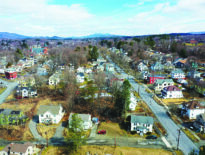
Andrew Mikula
Zoning laws – one of the arbiters of what can be built in a city and where – seem to have vastly different origins depending on who you’re talking to.
Proponents of slow, deliberate growth typically cite zoning as a successful effort to alleviate polluted and unsafe conditions in 19th century cities, for example by keeping heavy industry away from residential neighborhoods. Those seeking to loosen zoning laws tend to emphasize zoning’s long history of being used as a tool of race- and class-based exclusion.
Both these narratives are grounded in truth. Euclidian zoning was, and is, fundamentally an attempt to separate out incompatible uses. Sometimes, our societal definition of “incompatible uses” just needs some updating. Until shockingly late in the 20th century, many institutions treated housing for African Americans and housing for white people as incompatible uses.
Here in the 21st century, I’d argue that our understanding of the need to separate housing and industrial property needs some updating too.
Meaning of ‘Industrial’ Changing
In the past several decades, expanding environmental protections, rising land values, and broad shifts to a service-based economy have conspired to significantly reduce the presence of industrial space in Greater Boston.
Today, a lot of industrial zoning districts in the region resemble suburban office parks, and most others are much more likely to consist of storage facilities and fast food chains than emissions-spewing factories.
In this environment, several residential developments, often built under Chapter 40B, have cropped up in industrial and manufacturing zones. Watertown, Newton and Andover each host at least one, all of which currently have 4-plus-star ratings on Google Maps.
At a larger scale, Everett’s “Commercial Triangle,” which until 2018 was zoned for slaughterhouses and scrap yards, has added more than 1,000 apartments since 2023. Over a longer timeframe, Boston’s Seaport District has made a similar transition.
In an expensive and housing-starved region, this progression from industrial property to residential is only natural. Industrial uses tend to locate where land costs are low and transportation access is good.
But even amid the post-COVID commercial real estate collapse, the industrial property market has proven remarkably resilient, putting relocation pressure on industrial tenants as other costs rise. And many of the railroad lines that once made certain locations appealing for industrial uses have long since been abandoned or are primarily used for passenger vehicles.
Other States Ahead of Mass.
But few broad allowances for housing in industrial areas appear in local zoning.
Even Revere, the fastest-growing city in Massachusetts in the 2010s and one with a long industrial history, prohibits multifamily housing from its industrial zoning districts. And where local zoning does allow housing in commercial and industrial zones, it’s usually by special permit, opening the door to onerous conditions and lengthy approval timelines.
Other states have acted to zone for more housing in commercial and industrial areas. In August 2025, Texas passed a law that allows housing of at least 36 units per acre (more than twice the minimum density prescribed by the MBTA Communities law) in large cities where commercial, office, warehouse, retail or mixed-use development is also allowed.
At a national level, similar reforms poll well with the public. A 2023 Pew Research Center poll found that 75 percent of American adults favor “allowing housing near offices, stores, or restaurants.”
And anecdotally, there are good reasons to think that building housing on industrial properties, which tend to be located far from existing homes, could be even more politically palatable than projects in commercial centers. In Everett’s Commercial Triangle, projects with 300-plus units routinely sail through the approvals process while much smaller projects closer to most of the city’s population attract controversy.
Contamination Not Just a Liability
The prospect of cleaning up contaminated industrial sites, while difficult and expensive, could also help improve political feasibility. Everett even incentivizes new housing on former brownfields by reducing affordability mandates on sites requiring environmental remediation.
Given the region’s shortage of industrial space and local interest in expanding the commercial tax base, it could also be pertinent to allow some artisan manufacturers in residential zoning districts.
According to engineering firm AECOM, mixed-use industrial and residential zones not only promote the development of “cleaner, greener, quieter industry,” but also support job growth for those without a college degree. No one wants a chemical plant in their neighborhood, but what about a jewelry maker or a brewery?
The bottom line is that thoughtful rezoning of industrial land has a chance to both expand the housing stock and the amount of industrial space in Greater Boston. In the 21st century, (many) industrial uses are no longer incompatible with residential ones.
Andrew Mikula is the senior housing fellow at Pioneer Institute, a public policy think tank in Boston.






